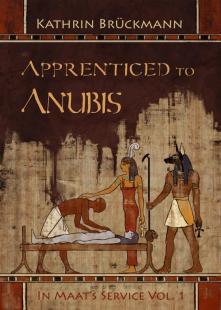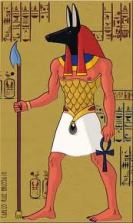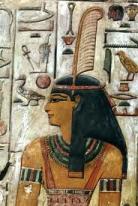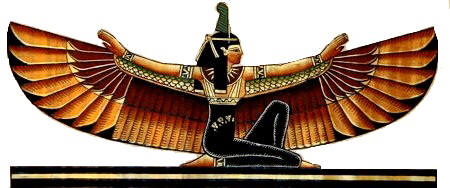 Here’s a murder mystery with a different twist. It’s set in ancient Egypt, in the reign of Pharaoh Senusret III, whose dates are 1878 BC to 1839 BC, which was a time of great power and prosperity. Pharaoh Senusret III was the fifth monarch of the Twelfth Dynasty of the Middle Kingdom. He was the one who achieved the building of the Canal of the Pharaohs, and was one of the few kings who were deified and honored with a cult during their own lifetime. If you care.
Here’s a murder mystery with a different twist. It’s set in ancient Egypt, in the reign of Pharaoh Senusret III, whose dates are 1878 BC to 1839 BC, which was a time of great power and prosperity. Pharaoh Senusret III was the fifth monarch of the Twelfth Dynasty of the Middle Kingdom. He was the one who achieved the building of the Canal of the Pharaohs, and was one of the few kings who were deified and honored with a cult during their own lifetime. If you care.
I could have just read through this book and enjoyed it, but I doubly enjoyed it because I looked up all the stuff I didn’t know about this time. Which was pretty much everything. Like Maat. The series is apparently called In Maat’s Service. Well, la di dah. Who is Maat? Yeah, well, who is Anubis for that matter? Google to the rescue!
Let’s start with Maat, because she is involved in the story. Sometimes it’s spelled Ma’at. (What are we supposed to do with those apostrophes in the middle of vowels? How do you pronounce an apostrophe?) Well, never mind, moving on. Maat, or Mayet, or Maae’t or māt or mayet, was the ancient Egyptian concept of truth, balance, order, law, morality, and justice. Maat was also personified as a goddess regulating the stars, seasons, and the actions of both mortals and the deities, who set the order of the universe from chaos at the moment of creation. (Thanks Wiki.)
Maat represents the ethical and moral principle that every Egyptian citizen was expected to follow throughout their daily lives. They were expected to act with honor and truth in manners that involve family, the community, the nation, the environment, and god. The King would describe himself as the “Lord of Maat” who decreed with his mouth the Maat he conceived in his heart.
Maat was usually represented as a young woman, sitting or standing, holding a was scepter, the symbol of power, in one hand and an ankh, the symbol of eternal life, in the other. Sometimes she is depicted with wings on each arm or as a woman with an ostrich feather on her head.
In the Egyptian underworld, the hearts of the dead were said to be weighed against her single “Feather of Ma’at”, symbolically representing the concept of Maat, in the Hall of Two Truths. This is why hearts were left in Egyptian mummies while their other organs were removed, as the heart was seen as part of the Egyptian soul. If the heart was found to be lighter or equal in weight to the feather of Maat, the deceased had led a virtuous life and would go on to Aaru. Here she is:
Now for Anubis, in whose service our protagonist is placed. Anubisis is the Greek name of a jackal-headed god associated with mummification and the afterlife in ancient  Egyptian religion. He attended the weighing scale during the “Weighing of the Heart.” He was depicted in black, a color that symbolized both rebirth and the discoloration of the corpse after embalming. Later on he seems to have been combined with Wepwawet (also called Upuaut), another Egyptian god portrayed with a dog’s head or in canine form.
Egyptian religion. He attended the weighing scale during the “Weighing of the Heart.” He was depicted in black, a color that symbolized both rebirth and the discoloration of the corpse after embalming. Later on he seems to have been combined with Wepwawet (also called Upuaut), another Egyptian god portrayed with a dog’s head or in canine form.
Like many ancient Egyptian deities, Anubis assumed different roles in various contexts. Depicted as a protector of graves as early as the First Dynasty (c. 3100 – c. 2890 BC), Anubis was also an embalmer. This is Anubis on the left. Looks kinda like a Doberman Pinscher.
Now, why are we interested in Maat and Anubis? Because our protagonist, young Hori has just finished his training as a doctor, and passes the oral exam. After a celebratory party held by the son of the Vizier, they all go off to a bar, where the son of the Vizier tries to molest a young serving girl. Hori, being the dutiful follower of Maat that he is, tries to prevent further abuse, knocking the guy, who trips and falls, hitting his head and dying. The father, being quite powerful, tries to bribe witnesses to claim that Hori deliberately killed the youth. Fortunately, enough witnesses tell the truth, and the young Pharaoh Senusret has to walk a fine line here between justice and the wishes of his Vizier. Instead of condemning Hori to death, or to a life sentences in the stone pit, (pretty much the same thing), he sentences him to life in The House of Death, the weryt, an intensely secret place on an island where the dead are brought, cleaned, and embalmed. However, this means that although Hori is allowed to live, he can never leave the weryt, and it would cause his death to reveal any of the secrets from there to anyone outside the weryt.
It is during his work here that young Dr. Hori discovers that several young girls who end up on his embalming table have the same kind of puncture wound. He sees a pattern, and believes they have been murdered. But by who? And why? And so begins our tale.
A good mystery woven throughout with the thoroughly researched details of life in that time in ancient Egypt. You may learn just a bit more about the embalming practices of the Egyptians that perhaps you quite wanted to, but I loved it. So all in all, the book has all the elements that I like in historical mystery fiction: a feeling of authenticity of the period, a decent mystery, some likable characters that we can cheer for, and enough detail that I can learn something new.
Kathrin Brückmann is a German writer, living in Berlin, and the original is in German, so we must give due kudos to the fine translation of Edith Parzefall. I believe further adventures of Doctor Hori and his best friend, Doctor Nakhtmin are planned. I certainly look forward to reading them.


[…] you want to learn something about ancient Egypt and be entertained in the bargain, try Apprenticed to Anubis, which is fiction, yes, a mystery, but just filled with nifty ancient Egyptian details. Way more […]
LikeLike
Thank you. I began this book last night and finally stopped at 3 am as I could no longer stay awake.
While I am an Ancient Egypt freak and just spent over a year reading nothing else – fiction, non-fiction, spiritual speculation, etc., I am enjoying this book as much as you seemed to and wanted to know if I was alone in that.
My favorite period is somewhat later, the Tao war to drive out the Hyksos, and this is filling in a time frame where I knew little.
Judith Anderson, Bibliomaniac
LikeLike
Judith, what did you think of the Mertz book?
LikeLike
I read her non fiction several years ago and it added a great deal to my knowledge of Egypt. I also love her Elizabeth Peters series re Amelia Peabody and recently reread the ones I had read as they came out and then the later ones and am eager awaiting the last, and that publication date has been delayed several times.
I am not so crazy about her Barbara Michaels series re Vicki Bliss but the info at the end of the last one, Laughter of Dead Kings, re the Peabody/Emerson family in the current day was fascinating.
Even though some of Pauline Gedge is now dated by more recent discoveries I love her research and books.
I am amazed by how many well written books there are set in Ancient Egypt.
As you can tell, I am a compulsive reader.
LikeLike
Thanks for the info on Pauline Gedge. I had never heard of her. Just snagged a couple of her books. (Depressing to think of how many really good writers there are of whom we have never heard, isn’t it.)
LikeLike
This is why we write/talk about books with each other. So many really good things and wonders to learn.
This is one of my favorite resources: http://www.fantasticfiction.co.uk/
They have all kinds of books listed, either by book title or author, and series are listed in order with mini write ups on many of them. There are also similar authors listed at the bottom for future possible reading.
I know that I look at my thousands of books, some read, some not, and I realize that at age 72 I am never going to get to them all now, but I keep buying more and expanding my interests.
Which Gedge books did you get? Some are stand alone and some are parts of sets. I do not have the King’s Man trilogy and it is not in either my public library or on Kindle.
My favorite is the trilogy of The Hippopotamus Marsh, The Oasis, and The Horus Road.
At the moment my vision is failing and I am reading on Kindle until I can get surgery to make things better.
LikeLike
I got the three Kings Man Trilogy, and the three Lords of Two Lands Trilogy. And I hear you about the number of books still to read. My TBR list is at least two lifetimes long.
LikeLike
The Lord of the Two Lands trilogy is the one I mentioned as my favorite of her books. Some of it has been disproved by recent discoveries, such as the identity of the Screaming Mummy, but it is so well done and each book has wonderful elements.
I look forward to your comments on both series.
LikeLike
[…] sand dunes look alike. You can refresh your memory about the previous book, Apprenticed to Anubus here. In fact, go read that blog entry now, because it has a lot of information in it which will be […]
LikeLike